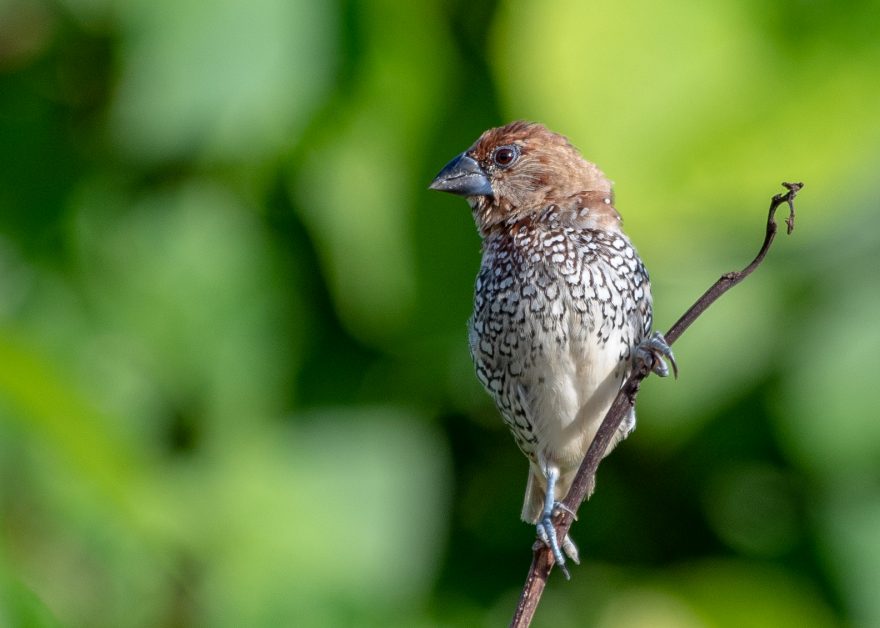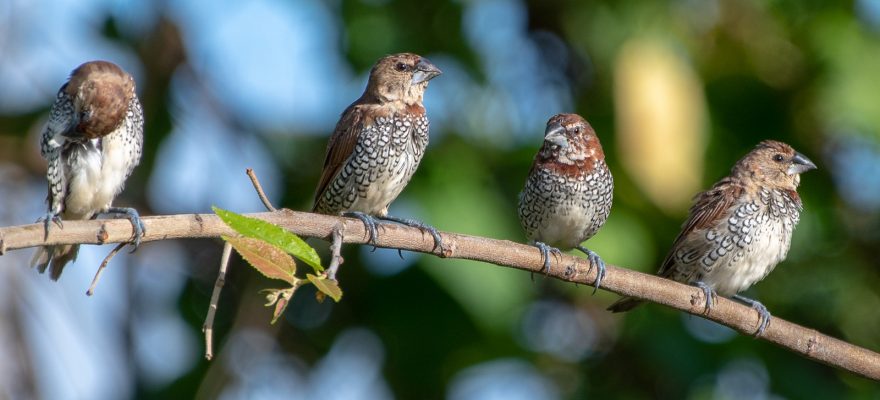The scaly-breasted munia or spotted munia—colloquially known as the spice finch in Australia—is a medium-sized finch found throughout tropical Asia. Feral populations have established themselves in Australia, the United States, and parts of South America. There are 11 subspecies found throughout their native range, however many feral and captive birds are likely to be intra-specific hybrids.
Spice finches are well established in aviculture, however their low monetary value can make them somewhat unpopular and difficult to acquire. They are illegal to possess in South Australia where they are considered to be an invasive pest. They are straightforward to look after and make for an excellent beginner’s bird.

Housing & Compatibility
Spice finches can be housed successfully as single pairs, a colony, or as part of a mixed collection. They prefer a large planted aviary, but can tolerate a smaller aviary or flight cage.
They can be quite disruptive in a mixed collection, so it’s best to avoid housing them with more delicate species unless the aviary is extremely large. They can be successfully housed with most placid finches, quail, doves, and (space permitting) Neophema parrots.
Spice finches should not be housed with any species with which they can hybridize, which includes all mannikins and munia species in the Lonchura family.
Diet & Feeding
A quality seed mix including canary seed, various millets and panicum forms the basis of the spice finch’s diet. Seed lacks many essential vitamins and minerals which must be compensated for by introducing other foods. Sprouted seed increases the nutritional value of seed and is a cheap way to improve your birds health. Freshly grown green seed heads should also be offered frequently.
Leafy greens should be provided throughout the year. Kale, bok choy, endive and silverbeet are the most nutritious and will be readily eaten. Spinach can also be given, but only sparingly as it can contribute to calcium deficiency.
Live food is an important component of the spice finch’s diet during the breeding season. Mealworms, maggots, termites, and small crickets will be consumed readily. Commercial soft finch food mixes can also be provided for an added nutrient boost. Outside of the breeding season their live food requirements are quite low.
Do not feed anything from the list of forbidden foods.

Breeding
Spice finches breed best in spring and autumn, with a hen bird that is at least 12 months of age. They can breed throughout the year if conditions are right.
A wide variety of artificial nests will be accepted, however they have a preference for a dense shrub just above ground level. In an aviary they will prefer to nest in a box rather than in a basket. They are generally tolerant of nest inspections, but this should still be kept to an absolute minimum.
They typically lay 4-6 eggs in each clutch, which are incubated by both parents for approximately 14 days. Young birds fledge the nest at three weeks of age and are usually independent a month later.
Young birds can be left in the aviary once they reach independence. A new nesting site and material may need to be provided at this stage, as Spice finches often refuse to re-use a nest for subsequent clutches.
Sexing
Spice finches are sexually monomorphic and are very difficult to visually sex. Males have a slightly larger lower mandible (the bottom part of the beak), but this isn’t a foolproof method of determining gender. DNA sexing may be required.
Mutations
None established.
Health
A strict worming and parasite control regime is essential to ensure the long-term health of any finch collection. We recommend worming with Moxidectin Plus. They do not spend a lot of time foraging at ground level, so their risk of contracting a parasite is somewhat lower than other common finch species.
Spice finches are long-lived for a finch, often reaching 8-10 years of age.